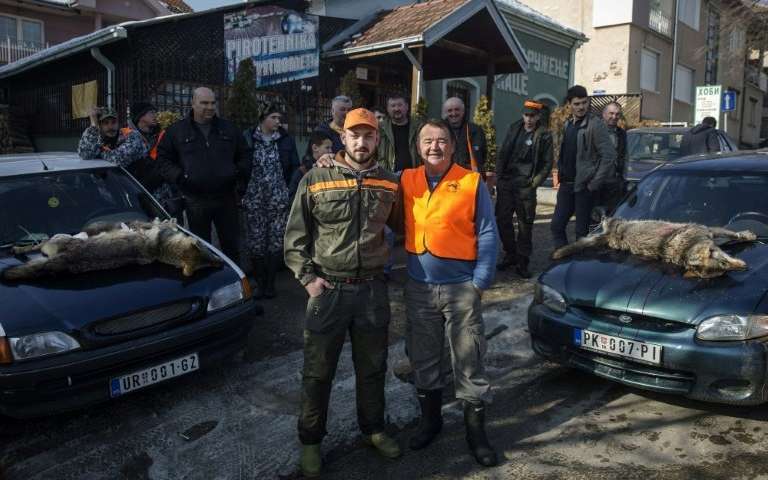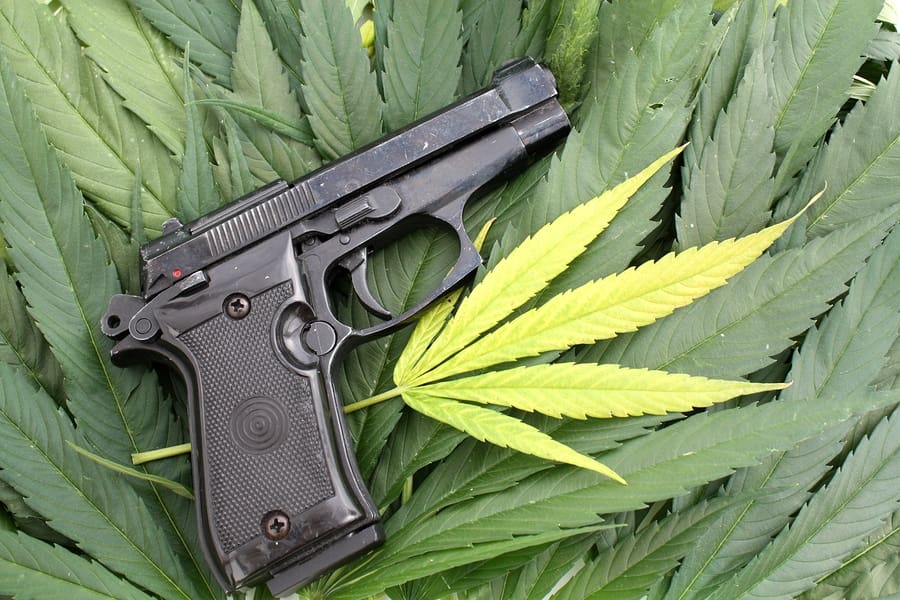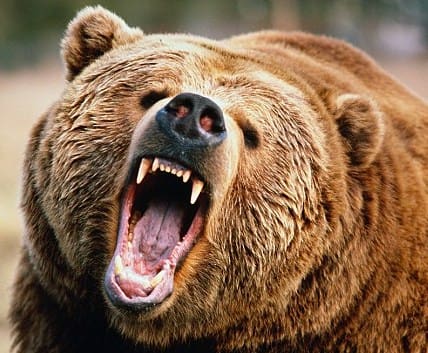Even a single wolf can devastate the hard work of farmers and ranchers. While wolf hunting is forbidden in most of Western Europe, it’s being allowed — for a short time — in Serbia’s southern forests . . .
Though much of the country is appalled by the “slaughter” of the illusive creatures, there are a few that hunt them with pride as Phys.Org reports.
Rifle fire rips through the silence of the forest and fields on the slopes of Jastrebac mountain in southern Serbia. Two wolves have just fallen victim to a legal hunt.
Forbidden in most of western Europe, the blood sport is allowed from July to April in this Balkan country, where wolves are not endangered.
Around 800 of them roam the wild and depopulated mountains of southern Serbia, a region of mostly poor farmers and herders. It is not uncommon for wolves to attack livestock, especially in winter.
Wolves aren’t seeking to make friends in rural country and they don’t discriminate when it comes to what or who they devour.
“Last year they slaughtered four of my sheep in just five minutes,” said farmer Ivan Milenkovic, who keeps around 60 sheep in the village of Dresnica.
“I installed spotlights that light up every night to deter them,” he told AFP.
Other mountain residents take up arms during the hunting season to counter the wolf attacks. Local hunting associations that monitor the wolf population set quotas.
On a recent cold winter’s dawn, more than 400 hunters gathered near Blace, a town of about 5,000 people between the mountains of Jastrebac and Kopaonik.
After swigging some rakija (local fruit brandy), the hunters split into two groups, the trackers and the watchers, and exchanged their traditional greeting: “Good vision and calm hand!”
The silent watchers spread out in a line through the woods, while the trackers form another line a couple of kilometres away and walk towards the watchers, squeezing the gap between them which holds their prey.
As they wait amid the trees, the watchers examine fresh wolf prints in the snow.
Six wolves in one season is hardly enough to make a dent in the population of wolves that can exist an a place where hunting them is forbidden.
According to regional hunting quotas, six wolves can be killed in the Blace area in one hunting season.
“You wait your whole life to kill a wolf,” said Dejan Pantelic, one of the hunters.
“It’s extremely rare, many never see it. I’ve been hunting for 24 years and I’ve not killed one.”
So clever that they can evade seasoned hunters and in most cases from even being seen at all. Sounds like the perfect killing machine to me.
The wolf is smart with an exceptional sense of smell and hearing, the 42-year-old explained.
And few animals are more mobile—the wolf can easily travel between 50 and 100 kilometres (31 and 62 miles) a day.
“An isolated hunter has practically no chance of killing a wolf, only an organised hunt can yield results,” Pantelic said.
Call me crazy but I’d like to try. Well, OK, with a guide. You?





Why not. Sounds like the wolf has all the advantage.
Now if I was a local farmer with skin in the game I’d probably take an active and vengeful approach to wolves eating my stock.
Sounds like great application for an evil AR(10)
In Serbia? Thick woods, I believe. I think I would rather have a drilling. Two 16 ga. barrels over a 7.62×54 barrel.
I just looked up serb gun laws. Looks like they can have quite a few guns, including pistols.
Still would like a drilling for that use.
Saw a very nice Drilling at last weekends gunshow. 12 ga/.06
Some places are just made for a drilling. The deep dark woods in Serbia sounds like one of those places. I’ve always liked the 16 ga. and from what I hear it’s still popular in europe so ammo would be easy. And I figure serbia probably has access to x54 ammo at decent prices also.
Use one round to hunt and two shot (00/000?) loads as defense against charging game?
(I’m probably wrong, but curious.)
Patrick. The drilling was designed for European style hunting. You might get the chance to shoot boar, deer, grouse, hare, etc. Put a mix of shells in your vest and you’re good for what comes along.
In the case of wolves I would load the shotgun barrels with 00 buck in one and 4 buck in the other. On moving targets in the thick stuff I would use the shot barrels and when it got open I’d use the rifle.
Back in the Tito days, Yugoslav citizens were required to keep a Mauser or SKS at home in case of Nazis, wolves, or Turks, etc.
Even though he was a commie, Tito was frequently at odds with Moscow. He apparently didn’t like Russians any more than Germans.
That’s quite understandable. The Balkans have been dominated by foreign empires for many centuries.
I’ve had Rakia. I would not want to be around hunters drinking Rakia.
Consumed in judicious (moderate) quantities, it might literally make the hunters more safe. Why? Because they would be a bit more relaxed and:
(1) would not be so fast to shoot at unverified targets,
(2) would be more steady holding their rifle on target, and
(3) would be more accurate because they would not overthink a shot.
I know this sounds crazy to some people. I have parallel first hand experience. A friend and I used to play a melee combat video game as partners, and we played it a LOT. When we were totally stone-cold sober, we would always fail somewhere at the “fifth level” of the game. When we had a couple beers and “loosened up”, we would always make it to the “seventh level” of the game before failing. And, needless to say, if we drank too much, we would get sloppy and flame-out far earlier than when we were sober.
We concluded that a couple drinks put our brains in a condition where we did not over analyze any situation and actually performed better. I can only imagine that the same would hold true for hunting.
Esoteric Inanity has had a similar experience with his slightly oafish bro. Skinner while sober is quite simplistic and has difficulty playing checkers. A few shots of firewater though, and the man becomes a chess prodigy. Not only can he comprehend how a knight maneuvers but has damn near beaten this one. If not for passing out upon the board and effectively ending the match.
Like I said, I’ve had the stuff. It never gave itself well to ‘moderate consumption’ and had a tendency to sneak up on you very unawares.
Alcohol intoxication, even at low levels, tends to reduce inhibition. Hence your ‘not overthink shots’ point.
When firearm safety is involved, inhibition is a good thing.
“Good vision and calm hand”
I like that! We need to appropriate that here in the States.
🤠
I caught an excellent video clip where a policeman had pulled over a drunk driver in the dead of winter somewhere in Siberia. The officer looks over his shoulder, then suddenly gets in the back seat of the drunk’s car. Seconds later, a huge pack of wolves comes racing down the street past them, one, two or three at a time, must have been easily 20 wolves or more.
During the first wolf delisting, since reintroduction into Yellowstone, in Wyoming back in the early 2000’s(08-09 IIRC), many wolves were killed in Teton, Subblette, Fremont and Cody county. Knowing the land and having snowmobiles helps, but having watched the bastards come and go unhindered for years while sewing havoc and learning their habits is the real advantage.
The other favored method of extirpation involved trapping and poisoning(questionable legality depending upon methodology during this period, but some ranchers didn’t give two shits). Now Esoteric Inanity isn’t much for poison, especially substances with a biocumalative effect. He also dislikes the idea of nonlethal traps as the thought of an animal suffering for prolonged amounts of time is disconcerting. Lethal traps have their own issues in that one can’t necessarily be certain of their target and the wrong animal may be killed.
Now an old family friend who lives up in the Hoback, came up with a fairly efficacious solution to some marauding wolves that had been ravaging his livestock. Rather than wait out all night in an old shed by the calf carcasses, his son set up a live feed cam at the sight. Afterwards the man got some of the old dynamite that his father had procured back in the 60s(No idea how he kept that safely for 40+ years, sweated dynamite is scary shit). Well, no doubt that one can envisage where this tale goes, for the more myopic it can be stated that several wolves were “taken care of”, some dangerous ordnance was disposed of and the valley was slightly woke that night.
Now to Esoteric Inanity’s understanding, a radio collared wolf went missing around this time back in 2005. The collar though, to this ones recollection, was recovered from the undercarriage of an eighteen-wheeler in Indiana.
Granted, some details of this tale have been “exaggerated” for humorous effect.
Anyone who refers to any animal as a bastard has some serious issues. Animals don’t do anything out of malice which is usually what a “bastard” would do. Hunters kill FAR more ungulates in any given rifle or bow season than any wolf in any given year. People kill far more cattle than wolves in any given year. Wolves might kill 50 cattle in a year when there are millions of cattle grazing in many states – largely on public lands for a pittance of a grazing fee. Hunters kill the biggest and baddest which weakens herds, wolves and other predators usually seek the frail, sick and elderly. Anyone who gets off killing something has deeper seeded issues that they are afraid to explore.
I’ll be in Alaska this fall for deer hunting and salmon fishing. I’d love to bag a wolf too. The tags are cheap!
You lucky guy. Good luck to you Tom
Im all for depredation if needed but i think this situation could easly be handled if farmers invested in a few livestock guardian dogs. Ex the anatolian Shepherd or kangal dog comes to mind.
If the wolves are half as smart as a coyote I’d be afraid to hunt them. Look how that coyote set up that preacher, I would rather not get shot in Serbia, I’ve heard it hurts worse to get shot when it’s cold.
“He got shot in Serbia! Quick, get the anatomy book and find out where the Serbia is located.”
certain wild-life has got to be culled/controlled…. OTW: they will, quite simply, over-run and consume every-thing….
AUssie, for instance, currently has a problem with kangaroos….
now protected, you need a very-hard-to-get “special permit” to hunt them…..
(in addition to a hard-to-get shooters license)
consequently, the country is almost over-run with mobs of them and they eat up all the pasture land and cause major car accidents and, occasionally, fatalities….. a full-sized ‘roo weighs as much or more than a large, buck deer….they can travel up to almost 40klmtr.p.hr …. one of them slamming into yr vehicle @ full speed is like hitting a brick wall….you’re cactus!
Wrong, people apply this theory when wildlife would do fine managing themselves if we would let them. Hunters want to kill ungulates and don’t want any competition from predators like wolves or bears. So, they kill them all off – then the ungulates are left to waste and disease because there are too many.
A wolf is not the same everywhere. Although there are many old tales of beaver trappers being attacked by wolves in winter, generally the American variety does not seem to go out of its way to hunt humans. There are of course, many instances where precisely this has happened.
The European wolf has a different history. In the middle ages, during a harsh winter, wolf packs roams the streets of Paris. In rural France, attacks by individual wolves go back a long way. In one case, a rabid wolf ran a 25 mile distance, biting and killing humans all along its path. In Russia, wolves have been a problem throughout recorded history. Hundreds of people have died in the jaws of wolves in the 19th century alone.
During World War One, there was a truce declared between Russian and German troops in the winter of 1915/1916. Wolf packs were attacking and eating sentries, supply troops, and began attacking trench lines. Combined forces of Germans and Russians fought against the wolf packs, using grenades, artillery and machine guns. When the numbers had been thinned out, hostilities recommenced. One cause was that all the wolf hunters and their guns had been called up by the Tsar. This matter was recorded in the New York Times.
Reports of wolves attacking humans, mainly women and children, continue to the present day.
So a wolf “falls victim to a legal hunt.” Would you please be kind enough to splain dat to an old grunt….(that is a Marine infantryman).
Enjoy the day.
Same mindless crap that you see uttered here on the hunting posts. I’m shocked I haven’t seen it on this post.
“The hunter should be charged with murder for killing that wolf.” Whole lotta snowflakes in the world.
Yes. Let’s take shots of high-octane hard-liquor and then go hunting in low light at dawn.
WCGW?
Trophy hunting is nothing more than glory killing with d*cks in hand. A true hunter would value the existence of apex predators to keep herds stable. They would enjoy a true hunt with tracking rather than baiting animals and using their hounds. They would take their kill and use every inch of it to for no waste. They wouldn’t take pictures with a deceased animal – nor would they allow them to be tortured, while getting off on it.
Facts matter: They argue that wolves are killing all the deer and elk. This just isn’t true. Ungulates and herds are “changing” for a variety of reasons: climate change, disease, traffic accidents, other predators, including bears, coyotes, and PEOPLE. The truth is, there are more than enough ungulates to go around. Wolves tend to seek out the old and sick – which strengthens a herd. Hunters on the other hand, want trophies. They want the biggest and baddest – and in so doing – they destabilize herds. In 2017, hunters took almost 200k deer during the gun hunting season in WI. Compare that to the approx. 13k that wolves take. In WI, there are approx. 1 million deer, well above the state goal of 731k (a 37% increase above). Wolves face great danger hunting ungulates and most often are injured in their attempts by a kick or antlers. If hunters are not finding ungulates as easily, look to mother nature – climate. Herds respond to climate and danger – they will move on and change behavior and they may not be as easy to locate. But, isn’t that what hunting is about? The tracking? Who wants to go find a herd in the same spot every time they go hunt particularly when many areas are baited to draw the animals in. Instead, wolves are blamed for causing these changes, when in fact it just really isn’t the truth.
Moving on to ranchers. The amount of takes of cattle are also minuscule compared to the amount of cattle that are put out feed on primarily public lands. IN WI, there are approx. 3.5 million cattle, in 2017, there were 31 confirmed cattle depredations by wolves. 31 compared to 3.5 million cattle? Ranchers are paid virtually double what their cattle are worth in a depredation. All paid for by taxpayers, with very small fees to graze by the rancher. What are the ranchers required to do in order to sustain and maintain their cattle? What non-lethal deterrents are they required to meet and adhere to before lethal action is taken? Range riders? Cattle bells? Fiash? Fox lights? The “kill” mentality does not work. Wolves will respond likely by taking more prey and by breeding more in an attempt to ensure survival. Further, cattle are a a particularly invasive species. Herds can cause massive damage to eco-systems and of course contribute to climate change through waste (including in our rivers and streams).
Comments are closed.